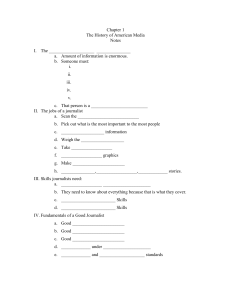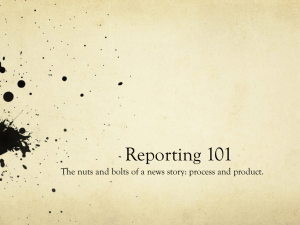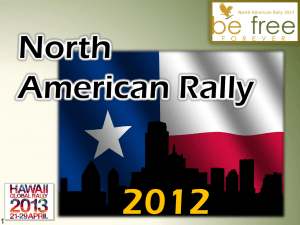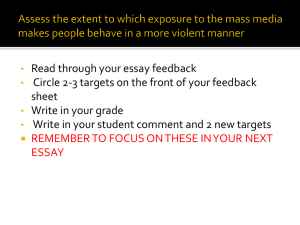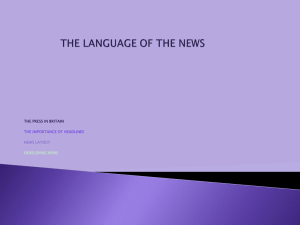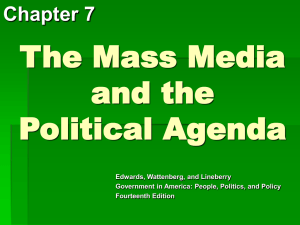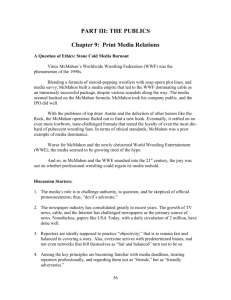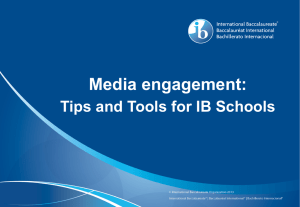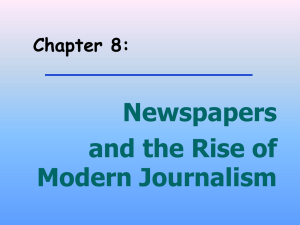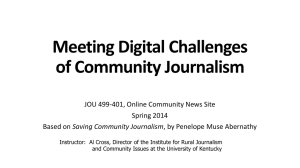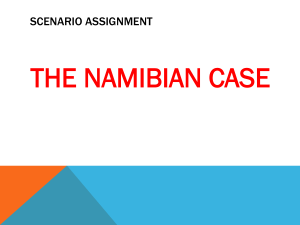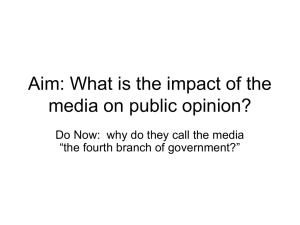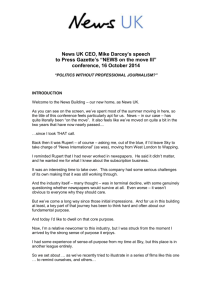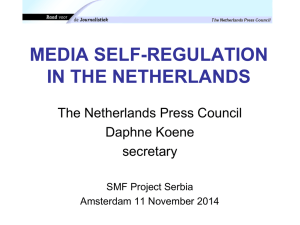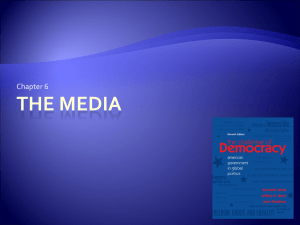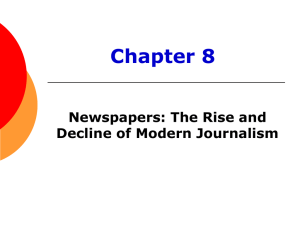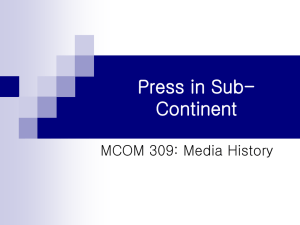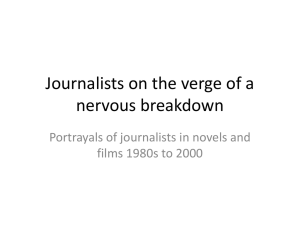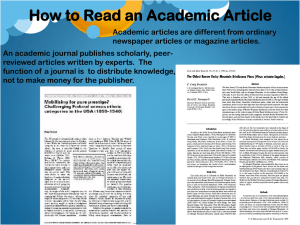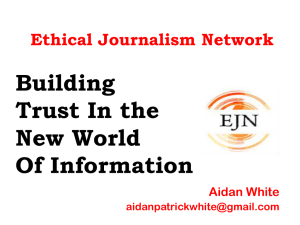The History of American Media
advertisement
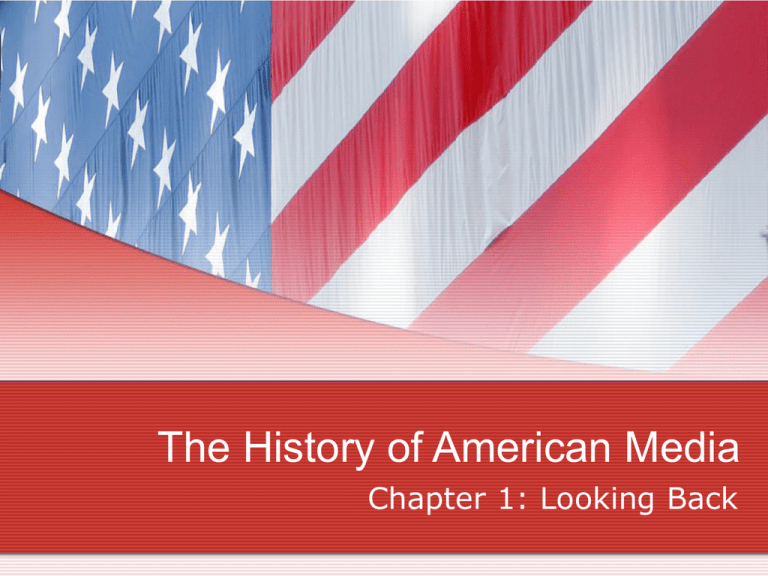
The History of American Media Chapter 1: Looking Back The Information Age • The amount of information available on-line is staggering. • Some of it is excellent—but some of it is junk • Somebody has to sort out all the information, make sense of it, organize it, judge it, and interpret it. • That is the job of a journalist. The Job of a Journalist 1. Scan the environment 2. Pick out what is the most important to the most people 3. Gather Information 4. Weigh the facts 5. Take Pictures 6. Design Graphics 7. Make Decisions 8. Write, package and deliver stories Skills Journalists Need • They need a broad education • They need to know about everything because that is what they cover— everything • They need people skills • They need language skills Journalist Fundamentals • Good sense • Good judgment • Good writing • Poise under pressure • Ethical and moral standards Classic Standards for Journalists • Be fair • Get it right • Don’t expect the technology to do your work. • “The news does not gather itself.” - Bob Mulholland, former NBC President Journalism and American History • Early newspapers printed essays that stirred the revolutionaries and that chronicled the historic break from England • Today journalists still help set the agenda. • Journalists help a democratic nation make historic decisions by providing facts and opinions needed to elect the leaders who decide national policy. America’s first newspapers • Did not look like the papers of today—they were usually one sheet and made up of letters, essays, etc. • Publick Occurrences was the first newspaper. It was published in Boston in 1690 by Benjamin Harris. • It was ended by the government after one issue. First Continually Published Paper • The Boston NewsLetter, started by John Campbell in 1704 • It was published “by authority”—it had the government’s approval • More and more papers emerged as pioneers moved south and west. Freedom of the Press • Early newspapers that criticized the government were guilty of sedition (the stirring of rebellion). • The truth of their statements was no defense. • In 1735, John Peter Zenger printed articles critical of the Governor William Cosby. He was arrested and thrown into jail. Freedom of the Press • Because Zenger printed attacks on the British crown, he was guilty of libel, even if the statements were true. • Andrew Hamilton defended him and appealed to the jury that everyone has the right to speak and write freely—as long as it is the truth. • The jurors deliberated briefly and found Zenger not guilty. The Birth of the Nation • The Zenger trial fanned the flames of freedom that were beginning to burn in the colonies. • By 1775, when the Revolution began, 37 newspapers were being published • They backed the Revolution and printed the cries to battle that rallied the rebels. • Some say there would not have been a Revolution without the support of the press. The Birth of a Nation • When the war ended, the framers of the Constitution did not spend much time on the freedom of the press, because most states already covered the matter. • However, the Bill of Rights was ratified in 1791. • In it, the First Amendment guaranteed the freedom of the press. The Birth of a Nation • After the Revolution, the nation grew rapidly, and so did the newspaper industry. • The first student newspaper, The Students Gazette, was founded in Pennsylvania, in 1777. • The first daily, The Pennsylvania Post, was founded in 1783. The Penny Press • Early papers had little actual news, but in 1833, Benjamin Day founded the New York Sun and filled it with news and sold it for only a penny. • Day’s staff covered the police beat, wrote about tragedies and natural disasters, and toned down the opinions. • This was the “penny press” and was the forerunner of today’s newspapers. The Penny Press • Because it was so inexpensive and was distributed widely, it developed a large audience. • Advertising began to take a major role. (which is still what funds newspaper today) • Two years later, James Gordon Bennett started the New York Morning Herald— selling for two cents, and more and more were founded in the years to come. The Penny Press • One of the most influential was the New York Tribune founded by Horace Greeley in 1841—its weekly edition had more than 200,000 subscribers. • The New York Times, was founded in 1851 by Henry Raymond. It is considered one of the best newspapers in the country. • It was not unusual for a city to have 8 or 9 competing newspapers. The Effect of the Telegraph • During the Civil War the telegraph began to be used to transmit stories. • Shortly afterwards, the first newsgathering service was formed. This service, a forerunner of the Associated Press, began selling news to papers in 1849. • By 1910, there were 2,600 daily newspapers in the United States. Yellow Journalism • An unethical irresponsible brand of journalism that involved hoaxes, altered photographs, screaming headlines, “scoops,” frauds, and endless promotions. • The most notable of the yellow journalists were William Randolph Hearst and Joseph Pulitzer. Their newspapers were in constant competition. Nellie Bly • The pen name used by Elizabeth Cochrane. • She worked for Pulitzer’s New York World and was noted for her “stunts,” stories in which she made the news herself. • She pretended to be mentally ill and was committed to an Asylum where she wrote an article exposing the awful conditions. The Advent of Radio • In 1906, Dr. Lee De Forest made improvements to the vacuum tube that made the new medium of radio possible. • De Forest made the first newscast in 1916. • Regular daily programs started in Detroit in 1920 The Advent of Radio • The National Broadcasting Company (NBC) was formed in 1926 and the Columbia Broadcasting System (CBS) in 1927. The Mutual Broadcasting system went on the air in 1934, and when part of NBC’s network was sold, it was renamed the American Broadcasting Company (ABC) The Advent of Radio • It became clear that the airwaves needed to be regulated. • In 1912, a law was passed to assign wavelengths to applicants • The Radio Act of 1927 broadened this power and created the Federal Communication Commission (FCC) which has power over both radio and television. The Advent of Radio • Radio still occupies an important place in the media • Most stations still play music mixed with news, and millions of Americans get their first word of major news events from radio as they drive to or from work or school. • There are also a lot of “shock jocks” and call in radio programs. The Radio and Journalism • It’s important to distinguish legitimate journalists from shock jocks and radio talk-show hosts. • Journalism is devoted to providing accurate, objective, untainted information that the public can use in their lives. • Part of the role of the journalist is to entertain, but that the exclusive aim of the jocks and hosts. They’re not journalists, they’re entertainers. The Impact of Television • The first television newscast took place in 1940 • TV dramatically changed radio and newspapers. • It took much of the entertainment role away from radio and claimed much of the breaking news role traditionally held by newspapers. • Papers today put less emphasis on breaking news. Assignment • Select a journalist from the list. Find out information on your journalist and discuss his or her role in American media. • You will be in groups of about 2-3. Someone in your group should be responsible for getting a picture of that person. • You will be putting this information together into a poster to display in the classroom. Block 2 • • • • • • • • Andrew Hamilton Cornelia Walter Robert S. Abbott Nellie Bly Benjamin Harris Ben Bagdikian Carl Bernstein David Brinkley • Gloria Steinem • John Quinones • Margaret BourkeWhite • Molly Ivins Block 4 • • • • • • • • John Campbell Benjamin Franklin Benjamin Day Anna Catherine Zenger Jane Grey Swisshelm Bryant Gumbel Christine Craft Edward R. Murrow • • • • • Helen Thomas Katharine Graham Marshall McLuhan Newton Minnow Walter Winchell
